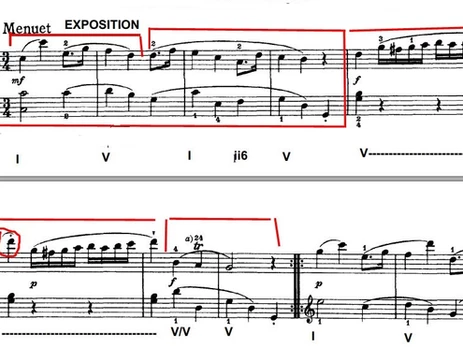Haydn Sonatas, Uncategorized
Haydn Sonata in C Major Hob XVI.7 – Divertimento
Haydn Sonata in C Major Hob XVI.7 – Divertimento
INTRODUCTION
This Divertimento is one of the little jewels of Haydn’s Sonata/Divertimento as it is one of the shortest he composed.
This Joseph Haydn composition has three movements:
Allegro moderato (C major)
Minuet (C major) – Trio (C minor)
Finale (C major)
It was composed in the year 1766 (initially for Harpsichord) and first published in 1895.
https://www.youtube.com/watch?v=-MvhDlTDYYg
ANALYSIS FIRST MOVEMENT of Haydn Sonata in C Major Hob XVI.7
The form of the first movement does not have yet the framing of a proper Sonata form, more closely to the title “partita”.
Partita
The exposition starts with an arpeggiation upon the tonic chord in contrary motion, the basic idea (b.i. on the score) a typical start of the Sonata form and characteristic from Haydn’s style.
The theme can be catalogued under the description of a Hybrid theme (Antecedent + Cadential) according to the classification given by William Caplin in his book “Analyzing Classical Music“.
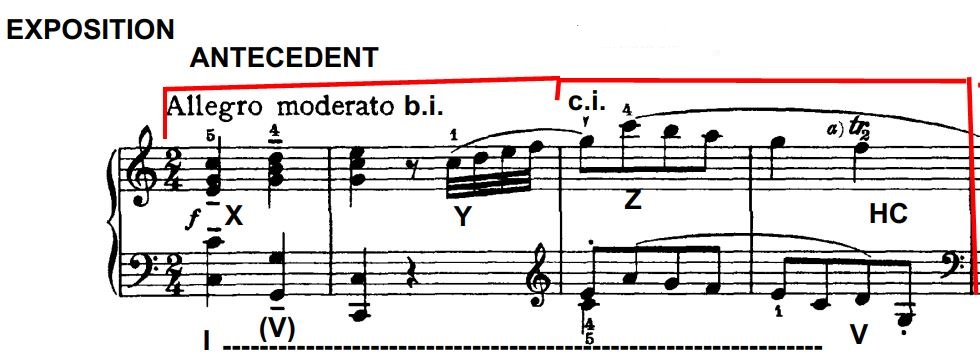
After the basic idea, we find the contrasting idea in bars 3-4 (c.i.) ending on a Half Cadence after a tonic prolongation on the tonic chord through bars 1-4, we observe an expanded cadential progression (C.E.P) in the consequent or second phrase which displays minimal characteristics of continuation function. The phrase is supported entirely by an expanded cadential progression through an acceleration of the harmonic rhythm, reinforcing the dominant chord, exclusively projecting a cadential function towards the key of the dominant, G Major.
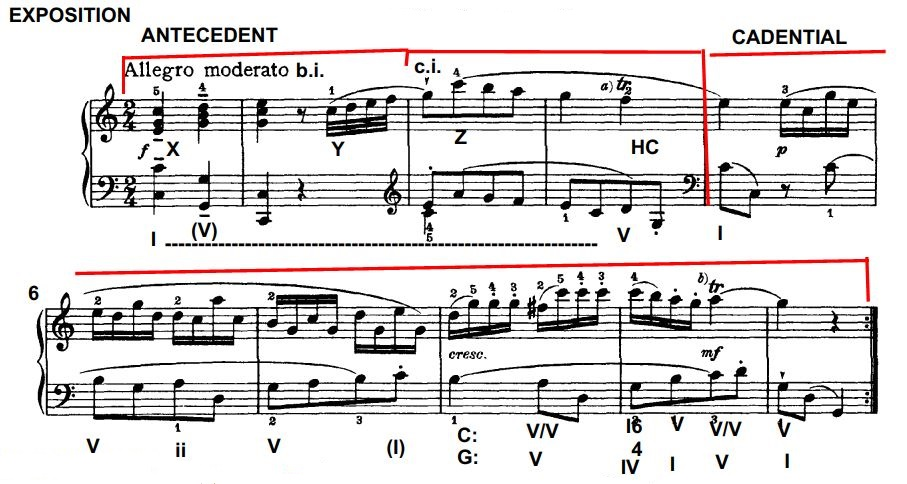
The Development section starts in bar 11, with an opening on G Major key, the dominant of the home key, C Major; this is typically the conventional key to go for any Sonata in Major mode.
Haydn decides here to prolong this harmony through a “Standing on the Dominant” (if you are interested in more information about this topic, you can go to another article written by Juan Rezzuto, click here)
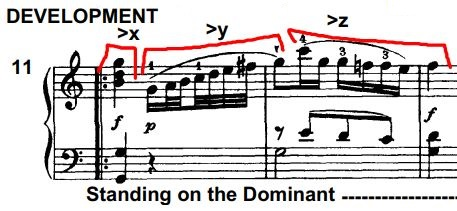
The development presents a variety of ideas taken from the exposition named with the lower cases “x, y and z”, respectively in bars 11 and 12.
The elaborated material appears under the symbol “>” which gives us the idea of from which of the specific motives does it come.
These ideas are repeated in bars 13 and 14 with the only difference that in bar 15 he directs through the chords of tonic and pre-dominants which goes to the dominant of the home key (G Major) in bar 16 intending to go back to tonic again as the Re-Elaboration starts in bar 17.
The Re-elaboration is a short section from bars 17 to 23 that cadences in the home key, C Major, instead of the dominant as he did on the exposition giving closure to this first movement.
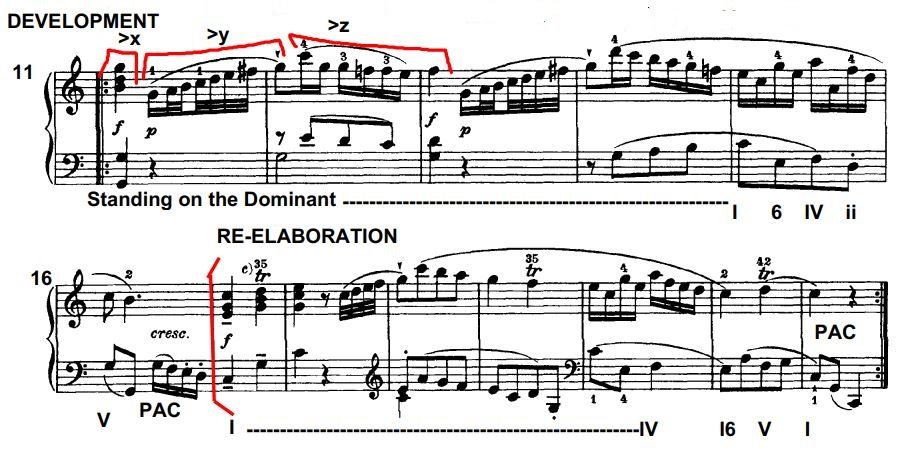
TECHNICAL ADVICE FOR PIANISTS
The technical approach for this movement should be impeccable, as we have fewer notes, the piece demands more subtlety than other more polyphonic works of the same composer.
It is advised to start with Arm movement for the opening. Special attention to the difference in voicing between right and left hands in bars 3 and 4 is recommendable as well. In bar 8, and according to the Scaramuzza ,,technique, the difference between the legato and staccato notes should be clear and concise. The use of wrist movement on the detached notes will bring delicacy to the passage.
ANALYSIS SECOND MOVEMENT: MENUET AND TRIO
A gentle and imaginative slow movement starts with a conventional Menuet and Trio form. The Menuet is in Small binary form (8 + 8), and the Trio in “minore” (or parallel minor mode) is presented under a rounded binary form.
The exposition of the Menuet begins with another example of a hybrid theme (Antecedent + Cadential) from bars 24 to 27 with a cadence on the dominant, just to be followed by a continuation on the same harmony to modulate towards G Major on bar 31. The overall structure of the exposition of this Menuet is 4 + 2 + 2. Bars 28 and 29 present an increment on the rhythmic activity through shorter values upon an ascending scale reinforcing the D note (dominant of the dominant).
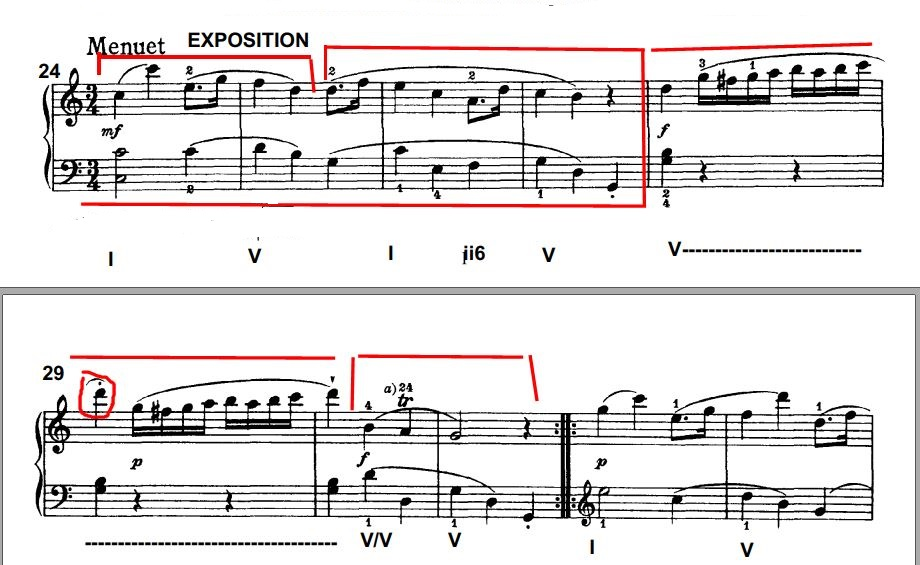
Bars 31 to 38 present the standard ” Contrasting middle + cadential”. The unit is supported by a single expanded cadential progression that reinforces the returning to the home key in C Major, ending on a P.A.C. (Perfect Authentic Cadence). Haydn takes care of the texture, making it the beginning on bar 31 to be more contrapuntal and thinner, bringing a contrast from the previous one and on bars 35 and 36 a much thicker and robust on the tonic chord on the left provides a confident return.
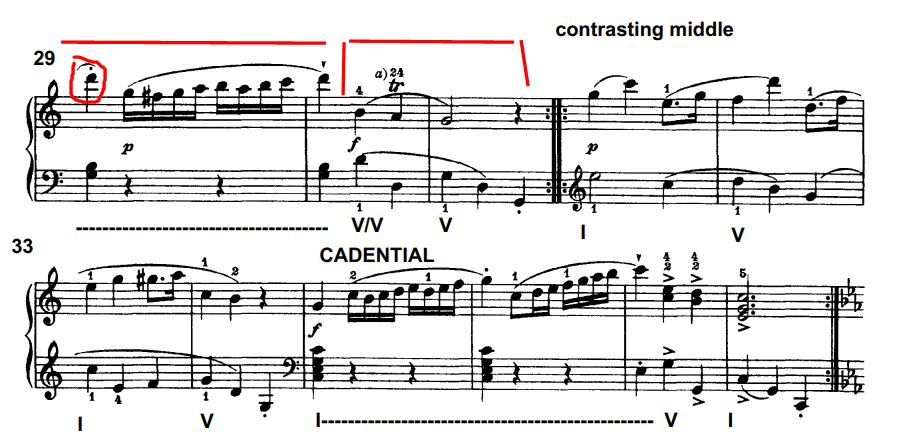
TRIO
This section is presented in “minore” which is one of the most typical regions for this type of section within a Menuet form.
The first 8 bars manifests through a sentence (conventional theme type according to Arnold Schonberg) having a basic idea in bars 39-40 upon the tonic level, which is immediately followed the statement-response on the dominant level, crystalising the presentation phrase.
The continuation phrase follows with new material in semiquavers in bar 43. Bar 44 reinstates a melodic idea, now in the dominant of the dominant that appeared in the basic idea (bar 40), the sentences close in a half cadence that lead to the contrasting middle section.
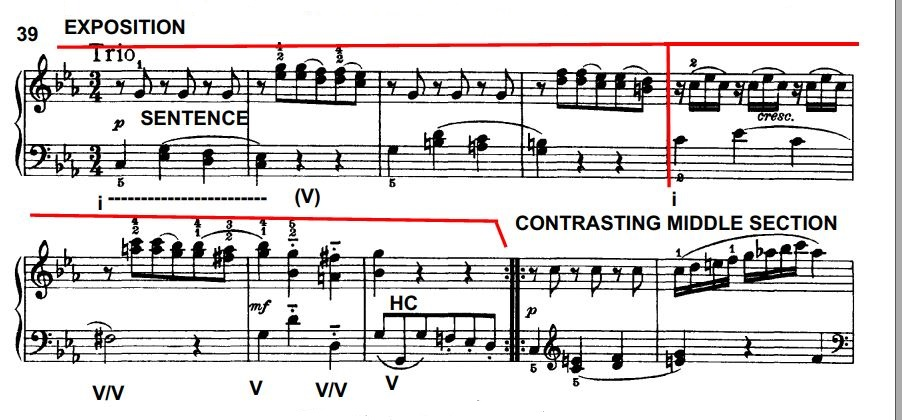
The contrasting Middle section elaborates the material presented in bar 39 (the beginning of the Trio) by making the harmonic texture thinner and the movement ascending on the left hand; This leads to a scalic passage in semiquavers that reminds us the rhythm in bar 43. The passage has a climbing nature through the ascending motion, making the overall gesture of the middle section more climactic. Harmonically, the contrast is given by the change to the parallel C Major, but a hint of colour is provided by the A-flat note in bar 43, resembling a diminished seventh chord. Bars 49-50 makes the return to the key of the exposition through the dominant of the dominant and a weak cadence on the dominant chord. The structure of this section is 2 + 2.
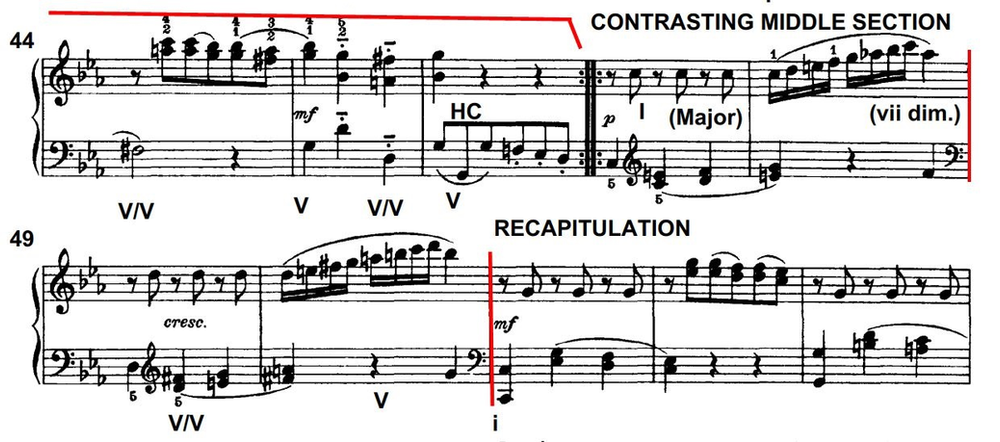
TECHNICAL ADVICE FOR PIANISTS
This movement demands lots of delicacy in the legato of the thirds. We can see the first example in the first bar (left hand): start with arm movement and then bind the rest of the thirds with finger movement.
In the next bar (right hand) the difference in the articulation of the thirds asks for thorough attention in detail, especially in the emphasis of which third is more pronounced; this will be accomplished by a refined technique of the arm movement.
Also, the three repeated notes on the basic idea (bars 39, 47, 51 and 53) should be performed by the forearm movement, always considering not to lift too far away from the keys but emphasizing the first beat of the bar to create the proper accent of a triple meter.
ANALYSIS THIRD MOVEMENTE: FINALE – ALLEGRO
At the beginning of the analysis, it was observed that the first movement does not have the structure of an “Allegro di Sonata”, which is the conventional place to be. This Sonata presents this form on the last movement “Allegro”.
The structure of the Theme A is 6 + 6, which is rather unconventional. Bars 60-61 presents an opening of the tonic chord reinforcing the chord notes (you can see them in red). The second part of the same theme in bars 62-64, the contrasting idea is mainly by step progression upon a pedal note on G, the dominant note of the scale. Harmonically we can observe a tonic prolongation from bar 60 to 65 in which Haydn returns to the basic idea (ars 60-61) falling into a conventional period. Bars 70 and 71 lead to the Dominant key, into Theme B.
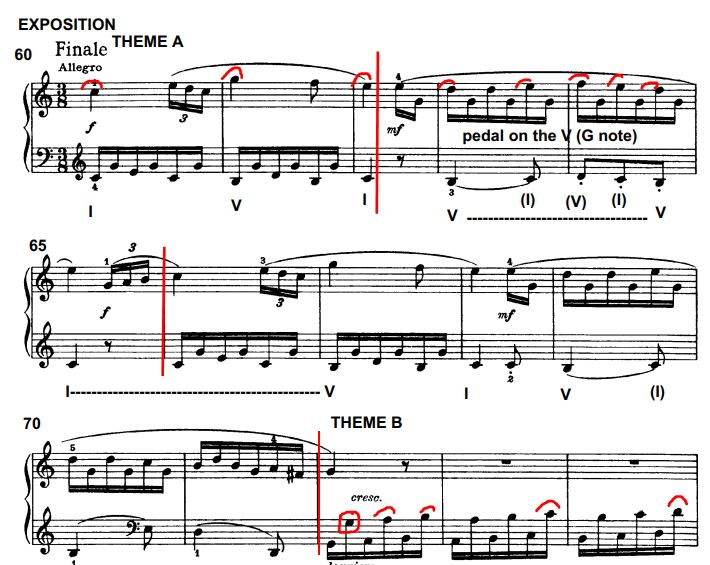
Theme B takes the step progression from the contrasting idea in Theme A and expands it into an interval of a 6th (from G to E – see the red coloured notes) Proportionally, Haydn is very careful as the overall structure of Theme B is also 6 + 6 in this section.
Theme B appears in bar 108 but now in the Tonic key, C Major, reinforcing the idea of a Sonata form.
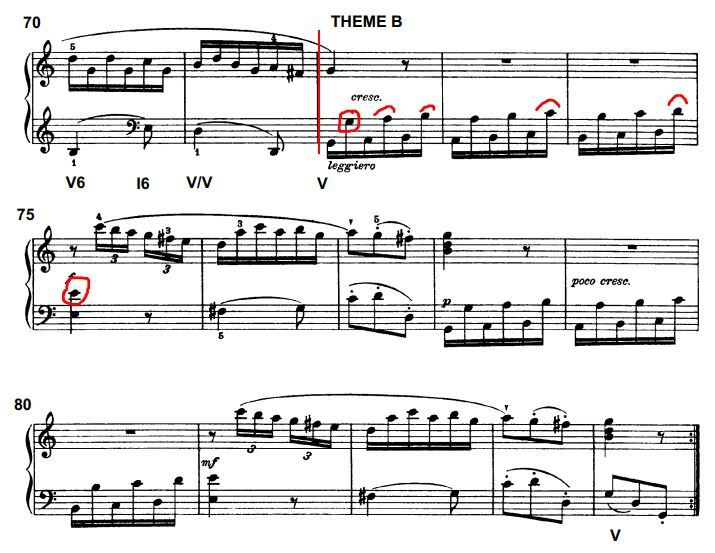
The Development section is mainly in G Major key. Still, some remarkable of this section is the use of a modal mixture or modal interchange in bars 93-95 to the Aeolian mode or natural minor on the Subdominant chord, C minor that serves as a pivot to return to C Major on the Recapitulation.
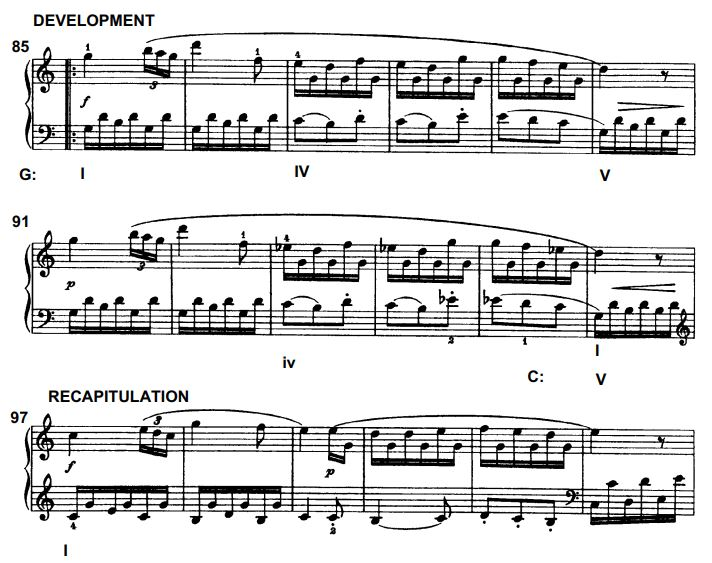
THEME B IN TONIC KEY:
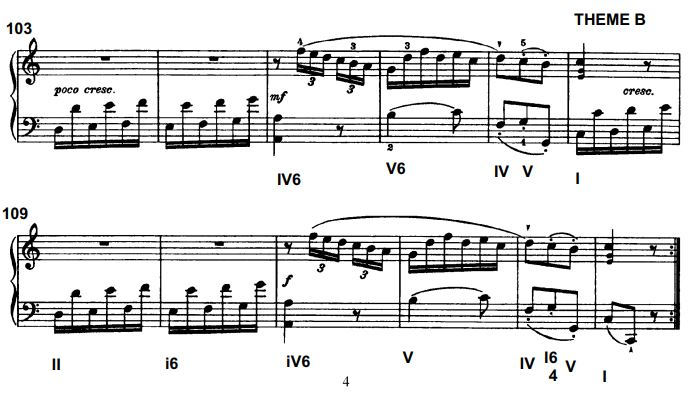
TECHNICAL ADVICE FOR PIANISTS on Haydn Sonata in C Major Hob XVI.7 – Divertimento
Rotation movement is advised for the pedal points passages, for example, in the Theme A (semiquavers) and especially in the broken octaves presented by the Theme B from bar 72.
The rotation will serve to emphasize the notes marked in red as they are part of a melody by step progression that is paramount to crystalize the form of the melody.
Other Haydn sonatas in C major:
–Keyboard Sonata in C major, Hob.XVI:35
–Keyboard Sonata in C major, Hob.XVI:21
–Keyboard Sonata in C major, Hob.XVI:48
–Keyboard Sonata in B Minor Hob XVI 32
Stay tuned for more Haydn creation of sonatas analysis for our Haydn Project !

